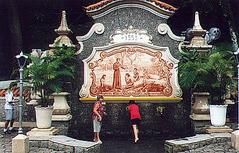Visiting Orquidário Municipal de Santos: Hours, Tickets, and Travel Tips
Date: 16/08/2024
Introduction
The Orquidário Municipal de Santos, located in Santos, Brazil (not Cubatão), is much more than a botanical garden—it is a living museum dedicated to the preservation, study, and appreciation of orchids and a vast array of plant and animal species. Established in 1945, the park owes its beginnings to Júlio Conceição, a trailblazer in Brazilian horticulture whose passion for orchids transformed his private estate, Parque Indígena, into the foundation for the Orquidário (Wikipedia). Today, this urban sanctuary spans over 24,000 square meters and is home to around 450 animals and a diverse collection of Brazilian and exotic plant species (Santos SP). The park plays a vital role in environmental education, conservation, and recreation, making it an essential destination for both locals and tourists.
Table of Contents
- History
- Main Attractions
- Visitor Information
- Travel Tips
- Nearby Attractions
- FAQ
- Conclusion
- References
History of Orquidário Municipal de Santos
Origins and Development
The history of the Orquidário is intertwined with the legacy of Júlio Conceição, who, in the early 20th century, amassed an extraordinary collection of over 90,000 orchids from around the world (Wikipedia). His estate, Parque Indígena, opened to the public in 1932 and featured exotic flora, fauna, decorative pavilions, and even benches made from whale bones (Turismo Santos). After Conceição’s death in 1938, the estate’s collection was sold to the city in 1944, laying the groundwork for the present-day Orquidário (Memória Santista).
Establishment and Evolution
Construction of the Orquidário began in 1943, and it was officially inaugurated on November 11, 1945. The park initially covered 24,240 square meters and included a large lake, orchid exhibition pavilions, and collections of native and exotic trees (Santos SP). Over the decades, it has expanded its facilities and collections, evolving into a key center for botanical and zoological research and environmental education.
Modernization and Legacy
Today, the Orquidário is recognized for its commitment to conservation, education, and community engagement. It plays a significant role in preserving endangered species and offers a variety of educational activities for all ages. The park has hosted notable visitors throughout its history, further cementing its place as a cultural landmark in Santos (Memória Santista).
Main Attractions
Orchid and Plant Collections
The Orquidário boasts over 3,000 orchid specimens across 120 species, displayed in naturalistic settings that mimic their native habitats (O Laviajantes). The gardens also feature bromeliads, ferns, palms, and native trees like pau-brasil and ipê-roxo.
Animal Life
About 450 animals—including birds, reptiles, and mammals—live within the park, with many species roaming freely. Notable residents include cutias, saracuras, pavões, turtles, and peacocks. The central lake attracts aquatic birds and is home to turtles and fish (O Laviajantes).
Educational Facilities
Visitors can explore interactive spaces such as the Sensory Garden (Jardim Sensorial), the Internal Visitation Aviary (Viveiro de Visitação Interna), and themed trails like the Honey Trail (Trilha do Mel). The park frequently offers workshops, guided tours, and holiday courses focused on conservation and environmental themes (Santos SP).
Events and Exhibitions
Special events—including orchid exhibitions, plant sales, and educational seminars—are held throughout the year. These events provide unique opportunities to learn about horticulture, conservation, and local biodiversity (Wild Trips).
Visitor Information
Hours
- Tuesday to Sunday: 9:00 AM - 6:00 PM
- Monday: Closed for maintenance
Tickets
- Adults: R$8.00
- Students, Seniors, Children (5-12): R$4.00
- Children under 5 and individuals with disabilities: Free
Group discounts and guided tour options are available upon request. For the most up-to-date information, check the official website.
Accessibility
The park is wheelchair-accessible, with ramps, accessible pathways, and reserved parking.
Amenities
Facilities include restrooms, seating areas, a café, and a gift shop with orchid-themed souvenirs.
Travel Tips
- Best time to visit: Spring and summer (September to March) offer the most vibrant floral displays. Early mornings and late afternoons are ideal to avoid crowds and heat.
- What to bring: Comfortable shoes, water, snacks, and a camera.
- Photography: The orchid pavilion, sensory garden, and lake are particularly photogenic. Please respect all park rules and wildlife.
- Special events: Check the park’s schedule for exhibitions, guided tours, and workshops (Wild Trips).
Nearby Attractions
- Santos Historical Center: Explore landmarks such as the Coffee Museum and Pelé Museum.
- Beaches: Popular options nearby include Gonzaga, Boqueirão, and José Menino, ideal for relaxing after your visit.
- Pinacoteca Benedicto Calixto: An art gallery featuring Brazilian artists.
FAQ
What are the visiting hours for the Orquidário Municipal de Santos?
- Tuesday to Sunday, 9:00 AM to 6:00 PM; closed Mondays.
How much are the tickets?
- R$8.00 for adults, R$4.00 for students, seniors, and children (5-12); free for children under 5 and people with disabilities.
Are there guided tours available?
- Yes, guided tours and group discounts are available. Check with the park in advance.
Is the park accessible for disabled visitors?
- Yes, with ramps, accessible paths, and facilities.
What else can I do nearby?
- Visit the Santos Historical Center, local museums, or the beaches.
Conclusion
The Orquidário Municipal de Santos is a unique blend of nature, history, and culture, offering something for everyone. Whether you are passionate about orchids, interested in conservation, or simply seeking a peaceful retreat in the heart of Santos, this park delivers an enriching experience. Its well-preserved landscapes, diverse collections, and engaging educational programs make it a highlight of the city. Combine your visit with a stroll through the historical center or a day at the beach for a perfect Santos getaway (Which Museum; Turismo Santos).
References
- Wikipedia: Orquidário Municipal de Santos
- Santos SP: História e Beleza em Santos
- Memória Santista: Parque Indígena – A Gênese do Orquidário Municipal
- Which Museum: Orquidário Municipal de Santos
- Turismo Santos: Orquidário
- O Laviajantes: Orquidário Municipal de Santos
- Wild Trips: Santos Top 10 Attractions
- Quartz Mountain: Things to Do in Santos
- Areas Verdes das Cidades: Orquidário Municipal de Santos

